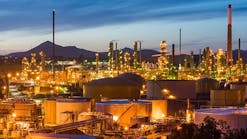Julian Castellanos, Jose Luis Cano, Rodolfo del Rosal, Victor M. Briones, Ruben L. Mancilla
Instituto Mexicano del Petroleo
Mexico City
A kinetic model has been developed that provides an improved tool for predicting yields from a visbreaking furnace.
The model also has application in the design of new and revamp of old units.
The development was based on quantitative and qualitative findings in previous studies concerning the thermal cracking of hydrocarbons, and on experimental data from an industrial project.1-6
Visbreaking is an old technology that appears uncomplicated and has been applied since nearly the beginning of the refining industry. But deeper understanding of the process fundamentals is now required in order to produce better designs and operations in an environment where competitiveness is a key factor.
In this context, the chemical kinetics of the thermal cracking reactions require particular attention within an overall model to predict the behavior of the reactor. Some models have been proposed to represent the kinetics, ranging from a very simple description with a single first order reaction,4 7-12 to more comprehensive reaction schemes using from three 13 to ten" pseudo components.
MODEL DESCRIPTION
In the proposed model, the feed and product hydrocarbons are represented by a set of discreet pseudo components characterized by their true boiling point, API gravity, and molecular weight.
The pseudo components are categorized according to the number of carbon atoms in their compounds. For example, the fifth pseudo component consists of all 5-carbon-atom compounds in the feedstock and products.
For the purpose of our discussion, n is equal to the number of discrete pseudo components, and i is equal to the number of carbon atoms in the compounds of a given pseudo component. It follows that i can be any number between 1 and n, inclusive.
Any i-carbon-atom component can have two degrees of saturation: Si and Oi. An Si component has a C/H ratio corresponding to the average degree of saturation of the feed components, and an Oi component has an equivalent structure, but with an unsaturation incorporated into the molecule. Oi components have two fewer hydrogen atoms than their corresponding Si components.
Each Si component undergoes a first order reaction (Fig. 1) producing, through i-2 parallel reactions, the set of lighter S components from Si-2 to S1, with simultaneous production of the corresponding O components. For a system represented by n pseudo components, there would be (n - 2)(n - 1)/2 such reactions. Conversely, each Si component is generated by the decomposition of any heavier S component, from Si+2 to Sn, also with simultaneous production of the corresponding O component.
This model does not consider the reactions of cracking, polymerization, or condensation of O components to yield lighter di-olefins or heavier hydrocarbons. It also does not represent the coking reactions of certain asphaltenic fractions.
The rate of change of the concentration of the ith S component (Equation 1) is derived from the difference between the contributions to its formation from the cracking of all heavier components, and the result of its cracking to each individual lighter component.
The rate of change in the concentration of the ith O component (Equation 2) is the result of the contribution to its formation from the cracking of all heavier S components.
In Equations 1 and 2, Ki,j represents the velocity constant of the cracking reaction for the ith S component, which produces the jth S component. Conversely, Kk,i and Kj,j-1 represent the velocity constants for the formation reactions from the cracking of heavier components.
The velocity constants' temperature dependence may be represented by the Arrhenius equation (Equation 3).
For a tubular reactor, as is commonly used in the visbreaking process, the rate of change of the concentration of components Si and Oi may be expressed in terms of the coil length and diameter, flow rate, and fluid density (see Equations 4 and 5).
To numerically solve these differential equations, some other considerations have to be incorporated into the model. This is necessary in order to obtain the elements for calculating the following variables for each tube length increment: pressure, temperature, vaporization, liquid density, vapor density, liquid-vapor density, flow velocity, local residence time, heat flux, transferred heat, and other physical properties of the fluid. These calculations have been previously described by the authors and are based on:
- Zonification models for the analysis of combustion chambers that allow the determination of the thermal fluxes in the tube coil, according to its position inside the chamber
- Thermo-physical proper-ties correlations
- Heat transfer coefficient correlations
- Liquid-vapor physical equilibrium prediction models
- Energy balances, incorporating the heat of formation into enthalpies, for including the thermal effect of the reaction
- Two-phase flow models for pressure drop prediction.
The number of S components required to represent the hydrocarbons present in the feed and products (51 by our calculations) represent, according to the model, 1,225 reactions with their corresponding Ki,j velocity constants, and 2,450 parameters to be fitted: 1,225 Ai,j's and 1,225 Bi,j's for Equation 3. This number is not only unwieldy for fitting purposes, but also well exceeds the number of information points.
It was necessary to incorporate certain generalizations into the development of Equations 6 and 7, which define the Ai,j and Bi,j constants of the Arrhenius equation (Equation 3) in terms of the molecular weights of the S reacting and product components.
The bases for these expressions are as follows:
The term (a0 + a1PMi + a2[PMi]2) in Equation 6 allows for the consideration of the higher reactivity of high molecular weight hydrocarbons.
The exponential term in Equation 6 is a normal distribution term which introduces the concept that each component ruptures preferentially in a particular C-C bond, and that other ruptures are normally distributed.
Equation 7 provides for the incorporation of two facts: that the activation energy depends upon the molecular size, and that, in a cracking reaction, the S component will usually have a smaller molecular weight than its corresponding O component.
FITTING MODEL TO INDUSTRIAL DATA
The eight model parameters were fitted to information obtained from the industrial operation of a Dubbs unit at the Azcapotzalco refinery in Mexico City that had been adapted to operate as a visbreaker, The reactor in this plant (Fig. 2) consists of three horizontal-fired heaters, with the third one unfired and providing additional residence time as a soaking section. Table 1 presents the coil dimensions of the furnaces.
The plant was operated with two different charges: atmospheric and vacuum residues from Maya and Isthmus crude oil with the characteristics shown in Tables 2 and 3. For each feedstock, the plant was operated under different conditions of flow rate (residence time) and temperature, as shown in Table 4.
Temperature measurements were taken at the exit of coil sections 4, 7, 13, 16, 19, and 21, and for each run, the coil was initially simulated with a simplified kinetic model using a single global reaction.7 Assuming that the final product distribution remains along the coil, physical properties, vapor-liquid equilibria, and volumetric flow rates were calculated as a function of the coil length.
These calculations provided a first estimate for the temperature vs. residence time dependence for each experimental run. With this functional relationship, it was then possible to numerically solve Equations 1 and 2.
The eight parameters; a0, a1, a2, a3, a4, b0, b1, and b2; were fitted by minimizing the square errors function defined by Equation B. In Equation 8, n is the number of experimental runs; I=1-4 represents residue (I=1), gas oil (I=2), gasoline (I=3), and gas (I=4); y1 is the weighting factor, y1,r and Y*1,r are the respective calculated and experimental yields for the rth run.
Powell's method15 was successfully employed as an optimization strategy and after 125 evaluations of the objective function, the minimum was confirmed.
With the first set of fitted parameters, the kinetic model was applied along the coil length to generate a new estimate of the temperature/residence time relationship, and the fitting exercise was again carried out. The convergence was obtained in only four iterations, and the following numerical values were determined:
a0 = 1.5072 x 10 12
a1 = 1.9 X 10 8
a2 = 0.20561 X 10 7
a3 = 146.95
a4 = 11.349
b0 = 42894
b1 = -4.5
b2 = 3
In general, the yields (wt %) calculated with these parameters are in quite good agreement with the experimental values (Table 5).
This kinetic model for thermal cracking reactions of petroleum fractions predicts conversion and yields of gas, gasoline, and gas oil in visbreaking operations.
The precision of the model exceeds that of the industrial measurements. The prediction errors may be partly due to experimental error, or to the associated modeling for the reactor.
This model is a valuable tool for a better analysis of the effects of temperature and residence time in visbreakers. The model has been successfully applied in the design of four units, one of them already in operation, for the improvement of existing units, and for revamping old thermal cracking installations.
REFERENCES
- Cooper, T.A., and Ballard, W.P., Advances in Petroleum Chemistry and Refining, Interscience Publishers, New York, 1963, Chapter 4, pp. 171-238.
- Hus, M., "Visbreaking process has strong revival," OGJ, Apr. 13, 1981, pp. 109-20.
- Rice, F.O., Herzfeld, K.F., Journal Am. Chem. Soc., 1937, p. 284.
- Sachaneri. A.N., Conversion of Petroleum, Reinhold Publishing Corp., New York, 1940.
- Storch, H.H., Kassel, L.S., Journal Am. Chem. Soc., 1937, p. 1245.
- Washimi, K., 2nd Unitar Heavy Crudes and Tar Sands Conference, Caracas, Venezuela, February 1982, Proc. 1262-67.
- Cano, J.L., Castellanos, J., " Reporte de Desarrollo de Tecnologia; Proceso de Reduccion de Viscosidad," institute Mexicano del Petroleo, Oct. 1978.
- Cano, J.L., Castellanos, J., Briones, V., del Rosal, R., "Analisis conceptual y avances tecnologicos en el proceso de reduccion de viscosidad," VIII Conv. Nal IMIQ, IV Pacific Area Chem. Eng. Congress, XIII Congreso Conf. Interam. de I.Q., Acapulco, Mexico, October 1988.
- Crawford, P.B., Cunningham, W.A., Petroleum Refiner, January 1956, pp. 169-73.
- Geniesse, J.C., Reuter, R., Ind. Eng. Chem., February 1932, pp. 210-22.
- Madwick, G.G., Amberg, C.H., Peterson, W.S., Can. Journal Chem. Eng., April 1959, pp. 65-70.
- Nelson, W.L., OGJ, Oct. 26, 1939.
- McNab, J.G., Smith, P.V. Jr., Betts, R.L., Ind. Eng. Chem., Nov. 1952, pp. 2556-63.
- Jacob, S.M., Gross, B., Voltz, S.E., AIChE J., 1976, pp. 701 11.
- Powell, M.J.D., Comp. J., 1965, pp. 303-07.
Copyright 1991 Oil & Gas Journal. All Rights Reserved.


